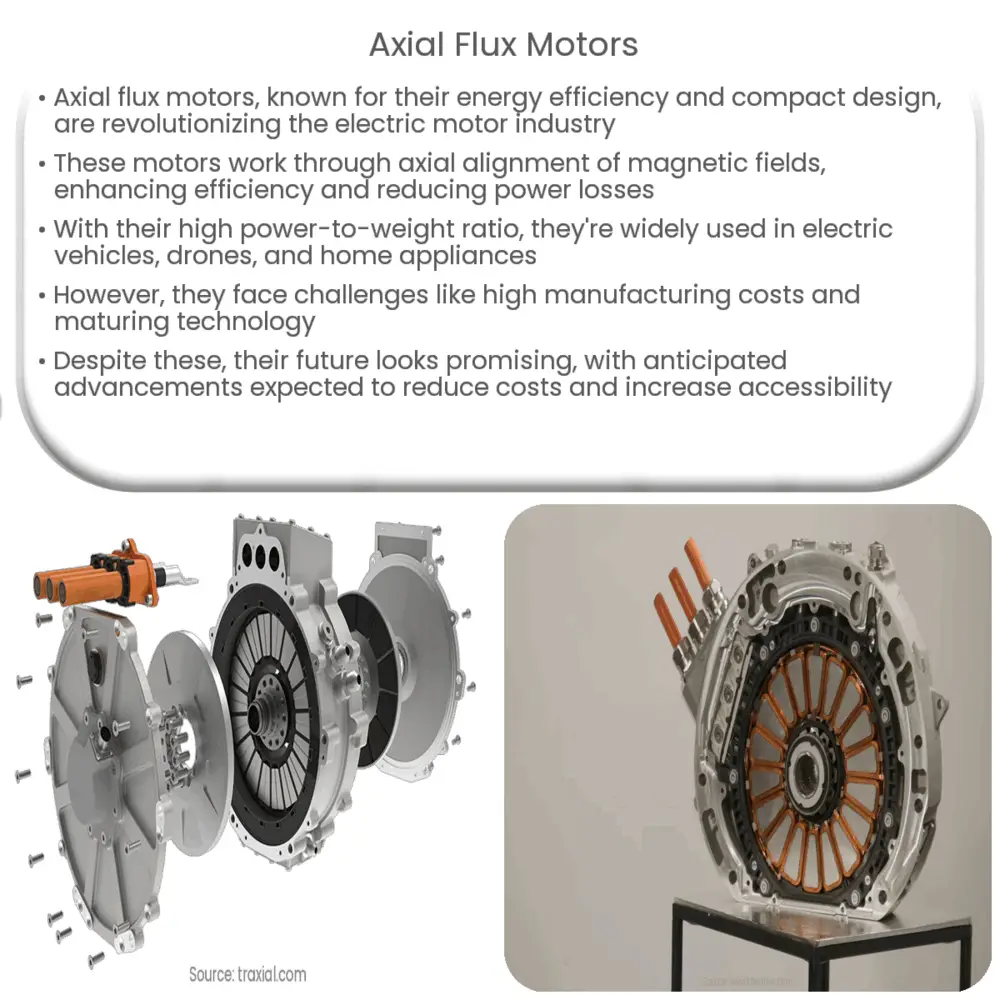Explore the intricacies of axial flux motors, their applications, advantages, challenges, and future outlook in our comprehensive guide.

A Brief Introduction to Axial Flux Motors
In the world of electric motors, a revolution is underway with the advent of axial flux motors. This technology is rapidly growing in popularity due to its superior energy efficiency and compact design. But what exactly is an axial flux motor, and how does it differ from traditional motors?
What is an Axial Flux Motor?
The axial flux motor, sometimes referred to as a ‘pancake motor’, is a type of electric motor where the magnetic field is aligned along the axis of rotation, hence its name. This structure is in contrast to the traditional radial flux motors, where the magnetic field follows a path along the radius of the motor.
Components and Working Principle
Key components of an axial flux motor include the rotor, stator, and windings. The rotor contains permanent magnets, while the stator, positioned parallel to the rotor, has windings that create a magnetic field when powered. The interaction between these magnetic fields generates torque, leading to rotation.
- Rotor: This component contains the permanent magnets which create a steady magnetic field. These are aligned parallel to the axis of rotation.
- Stator: The stator is the stationary part of the motor and houses the windings. When current is supplied, these windings generate an electromagnetic field.
- Windings: These are coils of wire through which electricity flows. The magnetic field produced by these windings reacts with the field from the rotor’s magnets, generating torque.
The magnetic fields created by the rotor and stator align in the same direction (axially), which is a key characteristic of axial flux motors. This configuration allows for a more efficient use of magnetic flux and reduces power losses, improving overall motor efficiency.
Applications of Axial Flux Motors
Due to their high power-to-weight ratio and compact design, axial flux motors are finding an increasing number of applications. They are prominently used in electric vehicles, where the need for energy efficiency and power density is paramount. But their use isn’t limited to transportation; they are also found in drones, home appliances, and industrial machinery. As our need for energy-efficient solutions grows, so too does the relevance of axial flux motors in our everyday lives.
Advantages and Disadvantages of Axial Flux Motors
One of the major advantages of axial flux motors is their high power density. Compared to traditional radial flux motors, axial flux motors can deliver the same amount of power in a significantly smaller package. This compact design is highly beneficial for applications where space is a constraint.
- High power density: Axial flux motors offer a higher power-to-weight ratio, making them suitable for applications such as electric vehicles and drones where space and weight are key considerations.
- Efficiency: The design of axial flux motors allows for more efficient use of magnetic flux, leading to reduced energy loss and better overall performance.
- Flexibility: The design of these motors is adaptable, which means they can be easily customized to meet specific requirements.
However, axial flux motors also come with their own set of challenges. One significant disadvantage is their relatively high manufacturing cost due to the precision required in aligning the rotor and stator. Furthermore, the technology is still maturing, and widespread adoption is yet to occur.
- Manufacturing cost: The complex design and high precision required make axial flux motors more expensive to manufacture.
- Maturity: As this technology is still relatively new, it might take some time for these motors to be adopted widely in all potential applications.
Future Outlook
Despite these challenges, the future of axial flux motors looks promising. As technology continues to advance, the manufacturing processes are expected to improve, potentially reducing costs and making the motors more accessible. The increasing demand for energy-efficient solutions is also driving the adoption of axial flux motors. As more industries recognize their potential benefits, the demand for these motors is expected to grow significantly in the coming years.
Conclusion
In conclusion, axial flux motors, with their unique design and operational benefits, are revolutionizing the electric motor industry. Their high power density and energy efficiency, combined with a compact design, make them a compelling choice for a variety of applications. Though the technology is still maturing, the ongoing advancements and increasing demand for efficient power solutions point to a bright future for axial flux motors.

